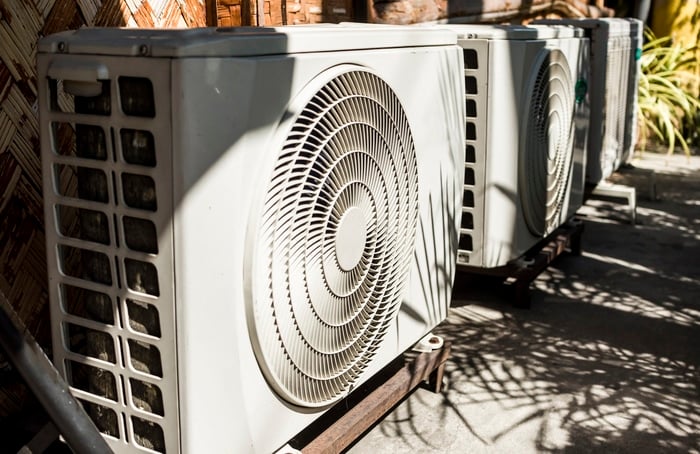Wondering whether you can use your air conditioner to heat a room?
You’re in good company! Although these appliances are most popular for cooling, there are thousands of people around the world that ask themselves the same question daily.
Air Conditioners are neither cheap to buy nor to run, so it would be great to be able to get your unit to cool during the summer, and keep you cozy on winter nights.
Whether this is possible depends on many factors, such as the model of the Air Conditioner you own, the settings you dial in, and much more. In order to make this clearer, I’ve prepared a small piece below with information I’m sure you’ll find useful. Once you get to the end, I’m certain that you’ll have all the answers you’re looking for and more.
Keep reading to make the most out of your appliance!
Addressing the Interior Exhaust Myth
Depending on how familiar you are with Air Conditioners and how they work, you may or may not know how the process of cooling air occurs. If you’re already an expert, feel free to move on to the next section. But if you’re a newcomer to the appliance troubleshooting world, it’s in your best interest to read on.
Air Conditioners work by pulling in warm air from inside your home, which they then pass through what is known as evaporator coils. These collect the heat through a liquid called refrigerant and transport it outside with the help of a compressor.
Once the warm air is in the outer world, it is dissipated through components called condenser coils, which are located in the external exhaust unit of your appliance. Some people believe that inverting the placement of your Air Conditioner (putting the intake outside, and the exhaust inside) can help warm your home.

And while this is a wild and interesting idea, it’s not quite true. Your appliance’s exhaust is designed to withstand external weather conditions such as rain and humidity, as well as debris, pollen, and dust, whereas the internal intake is not. Inverting their placement could quickly cause short circuits and other issues.
Moreover, although the exhaust does blow out hot air, it’s not enough to warm up your home. So, inverting the placement of your Air Conditioner is, sadly, not the best way to go about this.
Are There Any Models That Serve Both Purposes?
The short answer to this question is: yes. There are many models on the market that serve both purposes straight out of the factory, you just need to choose the right one.
A couple of decades ago, it was a lot harder to come by one of these models, as the main goal of an Air Conditioner is and always has been to cool living spaces. However, as technology advances and including additional features in appliances becomes “cheaper”, it makes no sense to restrict a cooling unit to just one function.

Now, this doesn’t mean that AC units with heating features are dirt-cheap – in fact, quite the opposite. On average, a central Air Conditioner system with no heating will cost anywhere between $1,500-4,000 plus installation costs of around $3,800-7,500, depending on the size of your home.
However, if you decide to go with heating, you might end up paying between $5,000-9,400 for the appliance, plus varying installation costs.
The best way to tell whether your current appliance has a heating feature is by checking your user manual. More often than not, all the questions you might have about the unit can be answered by giving it a quick read-through.
That being said, if you no longer have it or can’t find it anywhere, you can always go online. Just go to Google and search for “<Your Appliance’s Make And Model> User Manual”. The first result will likely be your manufacturer’s official website – click on it and find valuable information!
In summary, it is possible for an Air Conditioner to be used to heat a room, but it’s going to be considerably more expensive than just installing a classic cooling unit.
DIY Home Heating Tips
Lastly, let’s go over some simple things you can do around your home to keep it warm and cozy without using a central Air Conditioner heating system.
1. Make sure that your home is properly insulated:
Keeping external temperatures at bay is one of the easiest ways to lower your use of climate-control appliances and pay cheaper electricity bills. This might sound exaggerated, but even the smallest imperfections in your windows’ insulation can have a significant impact on your home’s internal temperature.
The simplest way to tell whether you need to place additional insulation is by looking at your window frames on a sunny day. If you see light dots peeking through it, you’ll need to cover them up. Also, you can try spotting water or humidity seeping through during rainy days, as this is another telltale sign of bad insulation.

2. Let the sun work for you:
Try leaving your curtains open during the day to get long-lasting heat from the sun’s rays.
3. Use other appliances to your advantage:
Learning how to use heat efficiently can help you save hundreds of dollars in utility bills every year. If you cook or bake regularly in the oven, leave the appliance’s door open after you’re down preparing your food and have turned off the gas supply.
Ovens are great at preserving heat, so yours should keep warming up the air around it for a couple of hours after use.
Conclusion
That about covers it.
Asking yourself whether your Air Conditioner can be used to heat a room is only natural. After all, with current electricity prices, it makes sense that you want to give a single appliance more than one purpose.
I hope this piece has helped you better understand that, in most cases, this is not only possible but likely already included as a feature in your unit. More often than not, you just need to tweak the right settings and read your user manual for confirmation.
Thank you very much for sticking with me all the way to the end. If this article piqued your interest and was helpful, you’ll be glad to know that we have many more resources you can keep learning from below.
On the site, you’ll find solutions for all sorts of everyday appliance issues, such as a refrigerator that’s always icing over, or a garbage disposal that’s shaking or vibrating.
I wish you all the best!
— Craig.






